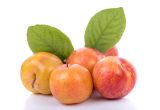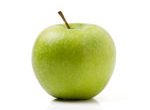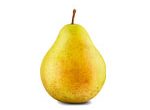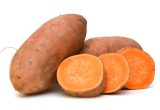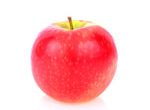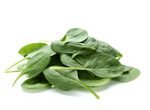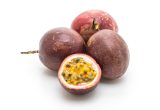Snow pea

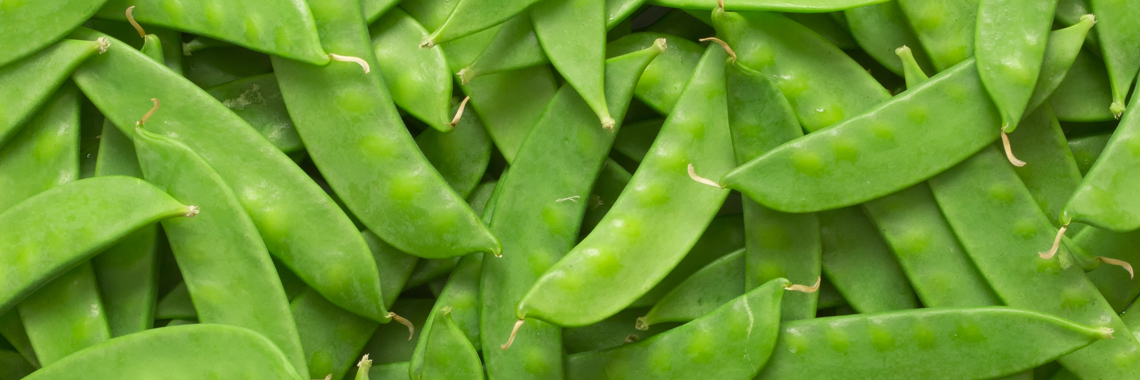
Description
- The snow pea or mangetout belongs to the Leguminosae family, genus Pisum, species sativum, variety sachhamatum or macrocarpon (Janick, 2001; Department of Agriculture, Forestry and Fisheries, 2011).
- Although it is also called “Chinese pea“, there is no evidence of its Asian origin, and its provenance is not clearly defined. Today, it is widely cultivated throughout the world (Janick, 2001; Department of Agriculture, Forestry and Fisheries, 2011).
PHYSICAL AND ORGANOLEPTIC CHARACTERISTICS
- Since the pod and seed are edible when still unripe (young), the snow pea appears flat at harvest, with a poorly developed seed and a thin-walled, non-rigid pod (El Seifi, 2014).
- The presence of chlorophyll gives the pea its green colour (El Seifi, 2014).
- It can be eaten raw, lightly boiled, steamed or sautéed (El Seifi, 2014).
COMPOSITION CHARACTERISTICS (excluding macronutrients, vitamins and minerals)
- Snow pea also contains 17.7 mg/100 g of phytosterols including 14 mg/100 g of β-sitosterol. Phytosterols contribute to the maintenance of normal cholesterol levels (Han, 2008; Regulation (EU) No 432/2012).
- Snow pea contains phenolic compounds (Ismail, 2009) that confer antioxidant activity. Its total antioxidant capacity (TAC) is between 500 and 1000 µM TE (antioxidant complex – Trolox equivalent) per 100 g (Pennington, 2009). This antioxidant capacity does not appear to be reduced after cooking in water (Wen, 2010).
RAW
The following values are approximate and depend on variety, season, ripeness, cultivation conditions, etc.
In the Ciqual table, the energy values are calculated from the contents of fat, protein, carbohydrates, dietary fibre, polyols, organic acids and ethanol, each with a specific energy value.
As raw snow pea is a food in which the presence of polyols and/or organic acids is suspected, Ciqual does not have compositional data to quantify them, so no energy value has been calculated.
COMPOSITION TABLES
For each nutrient, the tables provide information on the content, the minimum and maximum values, as well as the percentage of the Dietary Reference Values (DRVs) per 100 g net of raw snow peas.
MACRONUTRIENTS
| Constituent (g) | Average content |
Min-Max per 100g |
DRV% |
|---|---|---|---|
| Water | 88,30 | 85,70 - 89,20 | - |
| Fibers | 2,63 | 2,20 - 3 | - |
| Carbohydrates | 6,20 | 5,30 - 7,10 | 2,38 |
| Sugars | 4 | - | 4,44 |
| Lipids | 0,27 | 0,20 - 0,40 | 0,39 |
| Saturated fat | 0,039 | - | 0,20 |
| Protein | 3,08 | 0,40 - 4,38 | 6,16 |
| Constituent (g) | Amount | Min-Max | DRV% |
|---|---|---|---|
| Water | Ciqual 2020 | - | - |
| Fibers | Ciqual 2020 | - | Règlement (UE) N°1169/2011 du parlement Européen, et du conseil du 25 octobre 2011 |
| Carbohydrates | Ciqual 2020 | - | Règlement (UE) N°1169/2011 du parlement Européen, et du conseil du 25 octobre 2011 |
| Sugars | Ciqual 2020 | - | Règlement (UE) N°1169/2011 du parlement Européen, et du conseil du 25 octobre 2011 |
| Lipids | Ciqual 2020 | - | Règlement (UE) N°1169/2011 du parlement Européen, et du conseil du 25 octobre 2011 |
| Saturated fat | Ciqual 2020 | - | Règlement (UE) N°1169/2011 du parlement Européen, et du conseil du 25 octobre 2011 |
| Protein | Ciqual 2020 | - | Règlement (UE) N°1169/2011 du parlement Européen, et du conseil du 25 octobre 2011 |
Zoom on carbohydrates
- Raw snow peas contain a significant amount of carbohydrates (6.20 g per 100 g), well above the average amount of carbohydrates in raw vegetables (4.45 g per 100 g).
- Raw snow peas are low in sugar* (4 g per 100 g) as they contain no more than 5 g per 100 g.
Zoom on fibres
- Raw snow peas provide a significant amount of fibre, 2.63 g per 100 g.
- This amount is slightly higher than the average amount of fibre in raw vegetables (2.43 g per 100 g).
Zoom on proteins
- Their protein content (3.08 g per 100 g) is also higher than the average amount found in raw vegetables (1.87 g per 100 g).
Zoom on lipids
- The fat content of raw snow peas (0.27 g per 100 g) is lower than the average amount found in raw vegetables (0.56 g per 100 g).
- Raw snow peas are fat-free* as they contain less than 0.5 g of fat per 100 g.
*Regulation (EC) No 1924/2006 of the European Parliament and of the Council of 20 December 2006 on nutrition and health claims made on foods.
MINERALS AND TRACE ELEMENTS
| Constituent | Average content |
Min-Max per 100g |
DRV% |
|---|---|---|---|
| Calcium (mg) | 40,70 | 26,10 - 53,50 | 5,09 |
| Chloride (mg) | - | - | - |
| Copper (mg) | 0,079 | - | 7,90 |
| Iron (mg) | 2,08 | - | 14,86 |
| Iodine (µg) | - | - | - |
| Magnesium (mg) | 24 | - | 6,40 |
| Manganese (mg) | 0,24 | - | 12 |
| Phosphorus (mg) | 56,80 | 48,10 - 69 | 8,11 |
| Potassium (mg) | 200 | - | 10 |
| Selenium (µg) | - | - | - |
| Sodium (mg) | 4 | - | - |
| Zinc (mg) | 0,27 | - | 2,70 |
| Constituent | Amount | Min-Max | DRV% |
|---|---|---|---|
| Calcium (mg) | Ciqual 2020 | - | Règlement (UE) N°1169/2011 du parlement Européen, et du conseil du 25 octobre 2011 |
| Chloride (mg) | Ciqual 2020 | - | Règlement (UE) N°1169/2011 du parlement Européen, et du conseil du 25 octobre 2011 |
| Copper (mg) | Ciqual 2020 | - | Règlement (UE) N°1169/2011 du parlement Européen, et du conseil du 25 octobre 2011 |
| Iron (mg) | Ciqual 2020 | - | Règlement (UE) N°1169/2011 du parlement Européen, et du conseil du 25 octobre 2011 |
| Iodine (µg) | Ciqual 2020 | - | Règlement (UE) N°1169/2011 du parlement Européen, et du conseil du 25 octobre 2011 |
| Magnesium (mg) | Ciqual 2020 | - | Règlement (UE) N°1169/2011 du parlement Européen, et du conseil du 25 octobre 2011 |
| Manganese (mg) | Ciqual 2020 | - | Règlement (UE) N°1169/2011 du parlement Européen, et du conseil du 25 octobre 2011 |
| Phosphorus (mg) | Ciqual 2020 | - | Règlement (UE) N°1169/2011 du parlement Européen, et du conseil du 25 octobre 2011 |
| Potassium (mg) | Ciqual 2020 | - | Règlement (UE) N°1169/2011 du parlement Européen, et du conseil du 25 octobre 2011 |
| Selenium (µg) | Ciqual 2020 | - | Règlement (UE) N°1169/2011 du parlement Européen, et du conseil du 25 octobre 2011 |
| Sodium (mg) | Ciqual 2020 | - | - |
| Zinc (mg) | Ciqual 2020 | - | Règlement (UE) N°1169/2011 du parlement Européen, et du conseil du 25 octobre 2011 |
Zoom on minerals and trace elements
- Raw snow peas contain a significant amount of iron, manganese and potassium. They provide the equivalent of:
- 14.86% of DRVs for iron, i.e. 2.08 mg per 100 g;
- 12% of DRVs for manganese, i.e. 0.24 mg per 100 g;
- 10% of DRVs for potassium, i.e. 200 mg per 100 g.
- Other minerals represent less than 9% of DRVs.
VITAMINS
| Constituent | Average content |
Min-Max per 100g |
DRV% |
|---|---|---|---|
| Provitamin A Beta-carotene (µg) | 630 | - | - |
| Vitamin A equivalent (µg) | 105 | - | 13,13 |
| Vitamin B1 (mg) | 0,15 | - | 13,64 |
| Vitamin B2 (mg) | 0,08 | - | 5,71 |
| Vitamin B3 (mg) | 0,60 | - | 3,75 |
| Vitamin B5 (mg) | 0,75 | - | 12,50 |
| Vitamin B6 (mg) | 0,16 | - | 11,43 |
| Vitamin B9 (µg) | 42 | - | 21 |
| Vitamin C (mg) | 60 | - | 75 |
| Vitamin E (mg) | 0,39 | - | 3,25 |
| Vitamin K1 (µg) | 25 | - | 33,33 |
| Constituent | Amount | Min-Max | DRV% |
|---|---|---|---|
| Provitamin A Beta-carotene (µg) | Ciqual 2020 | - | - |
| Vitamin A equivalent (µg) | Calcul à partir de la valeur Provitamine A Béta-carotène* | - | Règlement (UE) N°1169/2011 du parlement Européen, et du conseil du 25 octobre 2011 |
| Vitamin B1 (mg) | Ciqual 2020 | - | Règlement (UE) N°1169/2011 du parlement Européen, et du conseil du 25 octobre 2011 |
| Vitamin B2 (mg) | Ciqual 2020 | - | Règlement (UE) N°1169/2011 du parlement Européen, et du conseil du 25 octobre 2011 |
| Vitamin B3 (mg) | Ciqual 2020 | - | Règlement (UE) N°1169/2011 du parlement Européen, et du conseil du 25 octobre 2011 |
| Vitamin B5 (mg) | Ciqual 2020 | - | Règlement (UE) N°1169/2011 du parlement Européen, et du conseil du 25 octobre 2011 |
| Vitamin B6 (mg) | Ciqual 2020 | - | Règlement (UE) N°1169/2011 du parlement Européen, et du conseil du 25 octobre 2011 |
| Vitamin B9 (µg) | Ciqual 2020 | - | Règlement (UE) N°1169/2011 du parlement Européen, et du conseil du 25 octobre 2011 |
| Vitamin C (mg) | Ciqual 2020 | - | Règlement (UE) N°1169/2011 du parlement Européen, et du conseil du 25 octobre 2011 |
| Vitamin E (mg) | Ciqual 2020 | - | Règlement (UE) N°1169/2011 du parlement Européen, et du conseil du 25 octobre 2011 |
| Vitamin K1 (µg) | Ciqual 2020 | - | Règlement (UE) N°1169/2011 du parlement Européen, et du conseil du 25 octobre 2011 |
Zoom on vitamins
- Raw snow peas are high in:
- vitamin C because they provide the equivalent of 75% of DRVs, i.e. 60 mg per 100 g;
- vitamin K1 because they provide the equivalent of 33.33% of DRVs, i.e. 25 µg per 100 g.
- They are also a source of vitamin B9 as they provide the equivalent of 21% of DRVs, i.e. 42 µg per 100 g.
- Raw snow peas contain a significant amount of vitamin B1, vitamin A, vitamin B5 and vitamin B6. They provide the equivalent of:
- 13.64% of DRVs for vitamin B1, i.e. 0.15 mg per 100 g;
- 13.13% of DRVs for vitamin A, i.e. 105 µg per 100 g;
- 12.50% of DRVs for vitamin B5, i.e. 0.75 mg per 100 g;
- 11.43% of DRVs for vitamin B6, i.e. 0.16 mg per 100 g.
- The other vitamins are present in smaller quantities, since they cover less than 6% of DRVs.
*Calculation made: Beta Carotene / 6 + retinol
POLYPHENOLS
BOILED
The following values are approximate and depend on variety, season, ripeness, cultivation conditions, etc. Also known as mangetout, boiled snow peas are low in energy* as they provide an average of 31 calories (kcal) per 100 g, i.e. 129 kJ.
COMPOSITION TABLES
For each nutrient, the tables provide information on the content, minimum and maximum values, as well as the percentage of the Dietary Reference Values (DRVs) per 100 g net of boiled snow peas.
*Regulation (EC) No 1924/2006 of the European Parliament and of the Council of 20 December 2006 on nutrition and health claims made on foods.
MACRONUTRIENTS
Constituent
(g)
Average content
Min-Max
per 100g
DRV%
Water
90,9
88,90 - 91,70
-
Fibers
2,80
1,80 - NC
-
Carbohydrates
3,39
-
1,30
Sugars
2,30
NC - 3,99
2,56
Lipids
0,30
0,23 - NC
0,43
Saturated fat
0,08
0,01 - NC
0,40
Protein
2,25
NC - 3,27
4,50
Constituent
(g)
Amount
Min-Max
DRV%
Water
Ciqual 2020 (valeur issue des analyses Ciqual-Aprifel 2018)
-
-
Fibers
Ciqual 2020 (valeur issue des analyses Ciqual-Aprifel 2018)
-
-
Carbohydrates
Ciqual 2020
-
Règlement (UE) N°1169/2011 du parlement Européen, et du conseil du 25 octobre 2011
Sugars
Ciqual 2020 (valeur issue des analyses Ciqual-Aprifel 2018)
-
Règlement (UE) N°1169/2011 du parlement Européen, et du conseil du 25 octobre 2011
Lipids
Ciqual 2020 (valeur issue des analyses Ciqual-Aprifel 2018)
-
Règlement (UE) N°1169/2011 du parlement Européen, et du conseil du 25 octobre 2011
Saturated fat
Ciqual 2020 (valeur issue des analyses Ciqual-Aprifel 2018)
-
Règlement (UE) N°1169/2011 du parlement Européen, et du conseil du 25 octobre 2011
Protein
Ciqual 2020
-
Règlement (UE) N°1169/2011 du parlement Européen, et du conseil du 25 octobre 2011
Zoom on carbohydrates
- Boiled snow peas contain less carbohydrate (3.39 g per 100 g) than the average amount found in cooked vegetables (4.85 g per 100 g).
- These are mainly glucose (1.60 g per 100 g), starch (0.80 g per 100 g) and sucrose (0.70 g per 100 g).
- Boiled snow peas are low in sugar* (2.30 g per 100 g) as they contain no more than 5 g per 100 g.
Zoom on fibres
- Boiled snow peas provide a significant amount of fibre, 2.80 g per 100 g.
- This amount is slightly lower than the average quantity of fibre in cooked vegetables (2.89 g per 100 g).
Zoom on proteins
- Its protein content (2.25 g per 100 g) is higher than the average amount found in cooked vegetables (2 g per 100 g).
Zoom on lipids
- The fat content of boiled snow peas (0.30 g per 100 g) is lower than the average amount found in cooked vegetables (0.53 g per 100 g).
- Boiled snow peas are fat-free* as they contain less than 0.5 g of fat per 100 g.
*Regulation (EC) No 1924/2006 of the European Parliament and of the Council of 20 December 2006 on nutrition and health claims made on foods.
MINERALS AND TRACE ELEMENTS
| Constituent | Average content |
Min-Max per 100g |
DRV% |
|---|---|---|---|
| Calcium (mg) | 35 | NC - 42 | 4,38 |
| Chloride (mg) | < 20 | 0 - NC | - |
| Copper (mg) | 0,08 | 0,07 - NC | 8 |
| Iron (mg) | 0,46 | NC - 1,97 | 3,29 |
| Iodine (µg) | < 20 | - | - |
| Magnesium (mg) | 14 | NC - 26 | 3,73 |
| Manganese (mg) | 0,18 | 0,17 - 0,34 | 9 |
| Phosphorus (mg) | 40 | 39 - 55 | 5,71 |
| Potassium (mg) | 100 | 83 - 240 | 5 |
| Selenium (µg) | < 20 | - | - |
| Sodium (mg) | 5 | 4 - NC | - |
| Zinc (mg) | 0,28 | NC - 0,39 | 2,80 |
| Constituent | Amount | Min-Max | DRV% |
|---|---|---|---|
| Calcium (mg) | Ciqual 2020 (valeur issue des analyses Ciqual-Aprifel 2018) | - | Règlement (UE) N°1169/2011 du parlement Européen, et du conseil du 25 octobre 2011 |
| Chloride (mg) | Ciqual 2020 (valeur issue des analyses Ciqual-Aprifel 2018) | - | Règlement (UE) N°1169/2011 du parlement Européen, et du conseil du 25 octobre 2011 |
| Copper (mg) | Ciqual 2020 (valeur issue des analyses Ciqual-Aprifel 2018) | - | Règlement (UE) N°1169/2011 du parlement Européen, et du conseil du 25 octobre 2011 |
| Iron (mg) | Ciqual 2020 (valeur issue des analyses Ciqual-Aprifel 2018) | - | Règlement (UE) N°1169/2011 du parlement Européen, et du conseil du 25 octobre 2011 |
| Iodine (µg) | Ciqual 2020 (valeur issue des analyses Ciqual-Aprifel 2018) | - | Règlement (UE) N°1169/2011 du parlement Européen, et du conseil du 25 octobre 2011 |
| Magnesium (mg) | Ciqual 2020 (valeur issue des analyses Ciqual-Aprifel 2018) | - | Règlement (UE) N°1169/2011 du parlement Européen, et du conseil du 25 octobre 2011 |
| Manganese (mg) | Ciqual 2020 (valeur issue des analyses Ciqual-Aprifel 2018) | - | Règlement (UE) N°1169/2011 du parlement Européen, et du conseil du 25 octobre 2011 |
| Phosphorus (mg) | Ciqual 2020 (valeur issue des analyses Ciqual-Aprifel 2018) | - | Règlement (UE) N°1169/2011 du parlement Européen, et du conseil du 25 octobre 2011 |
| Potassium (mg) | Ciqual 2020 (valeur issue des analyses Ciqual-Aprifel 2018) | - | Règlement (UE) N°1169/2011 du parlement Européen, et du conseil du 25 octobre 2011 |
| Selenium (µg) | Ciqual 2020 (valeur issue des analyses Ciqual-Aprifel 2018) | - | Règlement (UE) N°1169/2011 du parlement Européen, et du conseil du 25 octobre 2011 |
| Sodium (mg) | Ciqual 2020 (valeur issue des analyses Ciqual-Aprifel 2018) | - | - |
| Zinc (mg) | Ciqual 2020 (valeur issue des analyses Ciqual-Aprifel 2018) | - | Règlement (UE) N°1169/2011 du parlement Européen, et du conseil du 25 octobre 2011 |
Zoom on minerals and trace elements
- Boiled snow peas provide the equivalent of:
- 9% of DRVs for manganese, i.e. 0.18 mg per 100 g;
- 8% of DRVs for copper, i.e. 0.08 mg per 100 g.
- The other minerals represent less than 6% of DRVs.
VITAMINS
| Constituent | Average content |
Min-Max per 100g |
DRV% |
|---|---|---|---|
| Provitamin A Beta-carotene (µg) | 501 | 243 - 597 | - |
| Vitamin A equivalent (µg) | 83,50 | 40,50 - 99,50 | 10,44 |
| Vitamin B1 (mg) | 0,073 | 0,067 - 0,13 | 6,64 |
| Vitamin B2 (mg) | < 0,01 | NC - 0,076 | - |
| Vitamin B3 (mg) | 0,39 | 0,24 - 0,54 | 2,44 |
| Vitamin B5 (mg) | 0,22 | NC - 0,67 | 3,67 |
| Vitamin B6 (mg) | 0,022 | NC - 0,14 | 1,57 |
| Vitamin B9 (µg) | 56 | 29 - NC | 28 |
| Vitamin C (mg) | 20,60 | 13,90 - 47,90 | 25,75 |
| Vitamin E (mg) | 0,59 | 0,39 - 0,83 | 4,92 |
| Vitamin K1 (µg) | 3,87 | NC - 25 | 5,16 |
| Constituent | Amount | Min-Max | DRV% |
|---|---|---|---|
| Provitamin A Beta-carotene (µg) | Ciqual 2020 (valeur issue des analyses Ciqual-Aprifel 2018) | - | - |
| Vitamin A equivalent (µg) | Calcul à partir de la valeur Provitamine A Béta-carotène* | - | Règlement (UE) N°1169/2011 du parlement Européen, et du conseil du 25 octobre 2011 |
| Vitamin B1 (mg) | Ciqual 2020 (valeur issue des analyses Ciqual-Aprifel 2018) | - | Règlement (UE) N°1169/2011 du parlement Européen, et du conseil du 25 octobre 2011 |
| Vitamin B2 (mg) | Ciqual 2020 (valeur issue des analyses Ciqual-Aprifel 2018) | - | Règlement (UE) N°1169/2011 du parlement Européen, et du conseil du 25 octobre 2011 |
| Vitamin B3 (mg) | Ciqual 2020 (valeur issue des analyses Ciqual-Aprifel 2018) | - | Règlement (UE) N°1169/2011 du parlement Européen, et du conseil du 25 octobre 2011 |
| Vitamin B5 (mg) | Ciqual 2020 (valeur issue des analyses Ciqual-Aprifel 2018) | - | Règlement (UE) N°1169/2011 du parlement Européen, et du conseil du 25 octobre 2011 |
| Vitamin B6 (mg) | Ciqual 2020 (valeur issue des analyses Ciqual-Aprifel 2018) | - | Règlement (UE) N°1169/2011 du parlement Européen, et du conseil du 25 octobre 2011 |
| Vitamin B9 (µg) | Ciqual 2020 (valeur issue des analyses Ciqual-Aprifel 2018) | - | Règlement (UE) N°1169/2011 du parlement Européen, et du conseil du 25 octobre 2011 |
| Vitamin C (mg) | Ciqual 2020 (valeur issue des analyses Ciqual-Aprifel 2018) | - | Règlement (UE) N°1169/2011 du parlement Européen, et du conseil du 25 octobre 2011 |
| Vitamin E (mg) | Ciqual 2020 (valeur issue des analyses Ciqual-Aprifel 2018) | - | Règlement (UE) N°1169/2011 du parlement Européen, et du conseil du 25 octobre 2011 |
| Vitamin K1 (µg) | Ciqual 2020 (valeur issue des analyses Ciqual-Aprifel 2018) | - | Règlement (UE) N°1169/2011 du parlement Européen, et du conseil du 25 octobre 2011 |
Zoom on vitamins
- Boiled snow peas are a source of:
- vitamin B9 because they provide the equivalent of 28% of DRVs, i.e. 56 µg per 100 g;
- vitamin C because they provide the equivalent of 25.75% of DRVs, i.e. 20.60 mg per 100 g.
- Boiled snow peas also contain a significant amount of vitamin A. They provide the equivalent of 10.44% of DRVs, i.e. 83.50 µg per 100 g.
- The other vitamins are present in smaller quantities, since they cover less than 7% of DRVs.
*Calculation made: Beta Carotene / 6 + retinol
POLYPHENOLS
Nutrition and health claims
According to the definitions of nutrition claims as set out in Regulation (EC) No 1924/2006 on nutrition and health claims, and in view of the composition of the raw snow pea, the following claims may be used:
NUTRITION CLAIMS OF RAW SNOW PEA
- Low in sugar (100 g of raw snow peas contain no more than 5 g of sugar)
- Fat-free (100 g of raw snow peas contain no more than 0.5 g of fat)
- High in vitamin C (100 g of raw snow peas provide more than 30% of DRVs)
- High in vitamin K1 (100 g of raw snow peas provide more than 30% of DRVs)
- Source of vitamin B9 (100 g of raw snow peas provide more than 15% of DRVs)
HEALTH CLAIMS (for a consumption of 100 g of raw snow peas)
Vitamin C
- Vitamin C contributes to:
- normal function of the immune system during and after intense physical exercise,
- normal collagen formation for the normal function of blood vessels,
- normal collagen formation for the normal function of bones,
- normal collagen formation for the normal function of cartilage,
- normal collagen formation for the normal function of gums,
- normal collagen formation for the normal function of skin,
- normal collagen formation for the normal function of teeth,
- normal energy-yielding metabolism,
- normal functioning of the nervous system,
- normal psychological function,
- normal function of the immune system,
- protection of cells from oxidative stress,
- reduction of tiredness and fatigue,
- regeneration of the reduced form of vitamin E.
- Vitamin C increases iron absorption.
Vitamin K1
- Vitamin K1 contributes to:
- maintenance of normal bones,
- normal blood clotting.
Folates or vitamin B9
- Folates contribute to:
- maternal tissue growth during pregnancy,
- normal amino acid synthesis,
- normal blood formation,
- normal homocysteine metabolism,
- normal psychological function,
- normal function of the immune system,
- reduction of tiredness and fatigue.
- Folates have a role in the process of cell division.
Nutrition and health claims
According to the definitions of nutrition claims as set out in Regulation (EC) No 1924/2006 on nutrition and health claims, and in view of the composition of the boiled snow pea, the following claims may be used:
NUTRITION CLAIMS OF BOILED SNOW PEA
- Low in energy (100 g of boiled snow peas provide less than 40 kcal)
- Low in sugar (100 g of boiled snow peas contain no more than 5 g of sugar)
- Fat-free (100 g of boiled snow peas contain no more than 0.5 g of fat)
- Source of vitamin B9 (100 g of boiled snow peas provide more than 15% of DRVs)
- Source of vitamin C (100 g of boiled snow peas provide more than 15% of DRVs)
HEALTH CLAIMS (for a consumption of 100 g of boiled snow peas)
Folates or vitamin B9
- Folates contribute to:
- maternal tissue growth during pregnancy,
- normal amino acid synthesis,
- normal blood formation,
- normal homocysteine metabolism,
- normal psychological function,
- normal function of the immune system,
- reduction of tiredness and fatigue.
- Folates have a role in the process of cell division.
Vitamin C
- Vitamin C contributes to:
- normal function of the immune system during and after intense physical exercise,
- normal collagen formation for the normal function of blood vessels,
- normal collagen formation for the normal function of bones,
- normal collagen formation for the normal function of cartilage,
- normal collagen formation for the normal function of gums,
- normal collagen formation for the normal function of skin,
- normal collagen formation for the normal function of teeth,
- normal energy-yielding metabolism,
- normal functioning of the nervous system,
- normal psychological function,
- normal function of the immune system,
- protection of cells from oxidative stress,
- reduction of tiredness and fatigue,
- regeneration of the reduced form of vitamin E.
- Vitamin C increases iron absorption.
References
- Agence nationale de sécurité sanitaire de l’alimentation, de l’environnement et du travail. Table de composition nutritionnelle des aliments Ciqual 2020. Consultée le 07/09/2020 depuis le site internet Ciqual https://ciqual.anses.fr/
- Department of Agriculture, Forestry and Fisheries. Garden peas. South Africa : 2011, 32p
- El Seifi SK, Hassan MA, El-Bassiouny REI, Elwan MWM, Nasef IN. Changes in physical and chemical properties and determination of harvest time of snow peas as affected by pod development. Journal of Plant Production. 2014;5(2):315-24.
- Han JH, Yang YX, Feng MY. Contents of Phytosterols in Vegetables and Fruits Commonly Consumed in China. Biomedical and Environmental Sciences. 2008;21(6):449-53.
- Ismail A, Tiong NW, Tan ST, Azlan A. Antioxidant properties of selected non‐leafy vegetables. Nutrition & Food Science. 2009;39(2):176-80.
- Janick J (2001). Plant Breeding Reviews. John Wiley & Sons; p93-138.
- Pennington JAT, Fisher RA. Classification of Fruits and Vegetables. Journal of Food Composition and Analysis, 32nd National Nutrient Database Conference. 2009;22(décembre):S23-31.
- Wen TN, Prasad KN, Yang B, Ismail A. Bioactive Substance Contents and Antioxidant Capacity of Raw and Blanched Vegetables. Innovative Food Science & Emerging Technologies. 2010;11(3):464-69.
- Règlement (CE) N° 1924/2006 du Parlement européen et du Conseil du 20 décembre 2006 concernant les allégations nutritionnelles et de santé portant sur les denrées alimentaires.
- Règlement (UE) N°432/2012 de la Commission du 16 mai 2012 établissant une liste des allégations de santé autorisées portant sur les denrées alimentaires, autres que celles faisant référence à la réduction du risque de maladie ainsi qu’au développement et à la santé infantiles.
- Règlement (UE) n°1169/2011 du Parlement européen et du Conseil du 25 octobre 2011 concernant l’information des consommateurs sur les denrées alimentaires, modifiant les règlements (CE) n°1924/2006 et (CE) n°1925/2006 du Parlement européen et de Conseil et abrogeant la directive 87/250/CEE de la Commission, la directive 90/496/CEE du Conseil, la directive 1999/10/CE de la Commission, la directive 200/13/CE du Parlement européen et du Conseil, les directives 2002/67/CE et 2008/5/CE de la Commission et le règlement (CE) n°608/2004 de la Commission.




